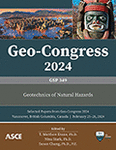Integration of Physical and Statistical Knowledge in Landslide Susceptibility Characterization
Publication: Geo-Congress 2024
ABSTRACT
Landslide susceptibility mapping (LSM) can provide valuable information for landslide characterization and mitigation. However, there are long-standing problems with LSM that have remained unaddressed or inadequately resolved, such as a lack of an effective framework to integrate the physical and statistical knowledge about landslide occurrence. To address the knowledge gap, this paper proposed to combine the physical model and machine learning techniques to produce a robust landslide hazard assessment. The hypothesis is that the physical modeling result itself can be a valuable model input to be incorporated in the training model of a machine learning framework. In this research, the tree augmented naïve (TAN) Bayes classifier has been selected as the machine learning model. In addition, we used PISA-m, a probabilistic landslide slope stability program, to estimate the probability of landslide occurrence in Magoffin County, Kentucky, United States. Results of physically assessed landslide susceptibility were used to be combined with other geomorphological variables in the TAN model to predict the landslide probability in the study area. We performed cross-validation to evaluate the model performance and reliability of the proposed methodology.
Get full access to this article
View all available purchase options and get full access to this chapter.
REFERENCES
Alvioli, M., and Baum, R. L. (2016). Parallelization of the TRIGRS model for rainfall-induced landslides using the message passing interface. Environmental Modelling & Software, Volume 81, 122–135. https://doi.org/10.5066/F73J3B27.
Anagnostopoulos, G. G., Fatichi, S., and Burlando, P. (2015). An advanced process-based distributed model for the investigation of rainfall-induced landslides: The effect of process representation and boundary conditions. Water Resources Research, 51(9), 7501–7523. https://doi.org/10.1002/2015WR016909.
Baum, R. L., Savage, W. Z., and Godt, J. W. (2008). TRIGRS: a Fortran program for transient rainfall infiltration and grid-based regional slope-stability analysis, version 2.0.
Cooper, G. F., & Herskovits, E. (1992). A Bayesian method for the induction of probabilistic networks from data. Machine Learning, 9(4), 309–347. https://doi.org/10.1007/BF00994110
Crawford, M. M., & Bryson, L. S. (2017). Assessment of active landslides using field electrical measurements. Engineering Geology, 233, 146–159. https://doi.org/10.1016/J.ENGGEO.2017.11.012.
Crawford, M. M., Dortch, J. M., Koch, H. J., Killen, A. A., Zhu, J., Zhu, Y., Bryson, L. S., & Haneberg, W. C. (2021). Using landslide-inventory mapping for a combined bagged-trees and logistic-regression approach to determining landslide susceptibility in eastern Kentucky, USA. Quarterly Journal of Engineering Geology and Hydrogeology, 54(4). https://doi.org/https://doi.org/10.1144/qjegh2020-177.
Friedman, N., Geiger, D., and Goldszmidt, M. (1997). Bayesian Network Classifiers. Machine Learning, 29(2–3), 131–163. https://doi.org/10.1023/A:1007465528199/METRICS.
Guzzetti, F., Reichenbach, P., Cardinali, M., Galli, M., and Ardizzone, F. (2005). Probabilistic landslide hazard assessment at the basin scale. Geomorphology, 72(1–4), 272–299. https://doi.org/10.1016/J.GEOMORPH.2005.06.002.
Hammond, C. (1992). Level I Stability Analysis (LISA) Documentation for Version 2.0 - Carol Hammond - Google Books (Vol. 285). US Department of Agriculture, Forest Service, Intermountain Research Station. https://books.google.com/books?hl=en&lr=&id=1_H3JErgbUAC&oi=fnd&pg=PA2&dq=Hammond,+C.+(1992).+Level+I+stability+analysis+(LISA)+documentation+for+version+2.0+(Vol.+285).+US+Department+of+Agriculture,+Forest+Service,+Intermountain+Research+Station.&ots=ZMZjUfjm0T&sig=1swCBpadp01vlku71YDnuuPqplw#v=onepage&q&f=false.
Haneberg, W. C. (2000). Deterministic and probabilistic approaches to geologic hazard assessment. Environmental & Engineering Geoscience, 6(3), 209–226. https://doi.org/10.2113/GSEEGEOSCI.6.3.209.
Haneberg, W. C. (2004). A Rational Probabilistic Method for Spatially Distributed Landslide Hazard Assessment. Environmental & Engineering Geoscience, 10(1), 27–43. https://doi.org/10.2113/10.1.27.
Jones, E., Slaughter, S., and Mirus, B. (2022). Landslide Inventories across the United States version 2. https://www.usgs.gov/maps/national-landslides-map-and-data.
Koller, D., and Friedman, N. (2009). Probabilistic Graphical Models: Principles and Techniques. MIT press.
Montgomery, D. R., and Dietrich, W. E. (1994). A physically based model for the topographic control on shallow landsliding. Water Resources Research, 30(4), 1153–1171. https://doi.org/10.1029/93WR02979.
Pei, T., and Qiu, T (2023). Landslide Susceptibility Mapping Using Machine Learning Methods: A Case Study in Colorado Front Range, USA. Geo-Congress 2023, 521–530. https://doi.org/10.1061/9780784484654.052.
Tien Bui, D., Tuan, T. A., Klempe, H., Pradhan, B., and Revhaug, I. (2016). Spatial prediction models for shallow landslide hazards: a comparative assessment of the efficacy of support vector machines, artificial neural networks, kernel logistic regression, and logistic model tree. Landslides, 13(2), 361–378. https://doi.org/10.1007/S10346-015-0557-6/FIGURES/7.
Varela González, P., and Medina-Cetina, Z. (2017). Risk Assessment for Landslides Using Bayesian Networks and Remote Sensing Data. Geo-Risk 2017, 113–123. https://doi.org/10.1061/9780784480724.
Information & Authors
Information
Published In
History
Published online: Feb 22, 2024
ASCE Technical Topics:
- Artificial intelligence and machine learning
- Business management
- Computer programming
- Computing in civil engineering
- Engineering fundamentals
- Geohazards
- Geomatics
- Geotechnical engineering
- Landslides
- Mapping
- Mathematics
- Mitigation and remediation
- Models (by type)
- Physical models
- Practice and Profession
- Probability
- Statistics
- Surveying methods
Authors
Metrics & Citations
Metrics
Citations
Download citation
If you have the appropriate software installed, you can download article citation data to the citation manager of your choice. Simply select your manager software from the list below and click Download.
